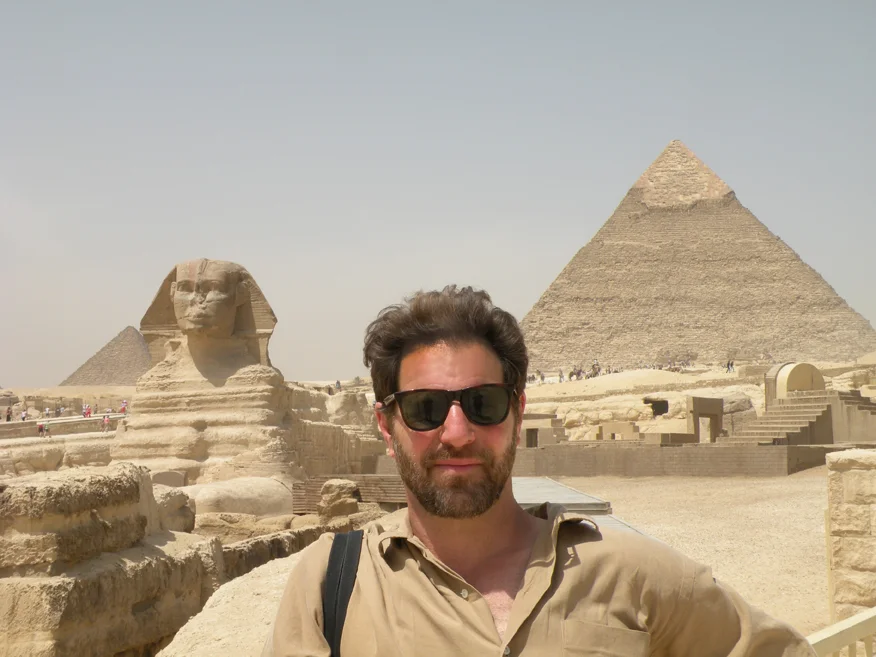On the Nile: Revolutionary Dining in Cairo
My first visit to Cairo was in April of 2010, before the political crisis, and it was clear that the city had been wracked by decades of abuse. Leprous looking ruins of once lavish apartment buildings lined downtown streets. Trash was piled everywhere, and desert sand collected in every nook and cranny. Thousands of unfinished, but occupied, housing blocks lined the road to the pyramids, their gaping, windowless balconies painted cheerful colors in a futile attempt to enliven the dreary surroundings. Verdant parks were few and far between. The famous National Museum, which houses an immense collection of ancient objects, seemed unloved, dowdy and disorganized, its walls sorely in need of a coat of paint.
Coming from another untamed city – Mexico – I was neither shocked nor surprised. And like Mexico City, some of Cairo’s most alluring aspects hide behind tattered façades. Roaming downtown I could sense the warmth, hospitality, vitality of Egypt’s biggest city. People smile, look you in the eye, call out in English, “where are you from?” - and they really want to know. I was advised that Cairo is a very safe city so I wandered in areas that would seem off-limits anywhere else. Ratty, trash-strewn streets revealed wonders at every bend. Cows, sheep, goats, even camels live in the middle of this metropolis. Food is sold from gaily hand-decorated wooden pushcarts. Festive appliquéd fabric tents are set up in empty lots for a funeral or a wedding, to which the whole neighborhood is invited. Shops spill out onto the sidewalk (if there is one). Men, and a few women, sip tea and puff on sheesha pipes at cafés. I saw few foreigners in these areas but I always felt welcome and comfortable. For two weeks I avoided the obvious tourist sites, preferring to spend my days wandering the streets.
I have always enjoyed making connections through food; I believe it provides a window into the soul of a people. The back streets of Cairo provided a perfect setting for seeking out that soul.
The word “cuisine” is a bit high-falutin’ for Egypt’s simple, generically ‘Middle Eastern’ cooking. While there are a number of well-loved national dishes such as koshary and fuul, fancy, sophisticated fare tends to emanate from Lebanon or Syria. Following the familiar middle eastern/north African dining protocol, meze (small appetizers) are followed by more elaborate dishes eaten by hand, with bread taking the place of silverware. Recipes are simple. Absent are the complex spice mixtures and heady savory-sweet dichotomies of Morocco or Tunisia. Missing is the wide variety of fish, meat and vegetables in Turkish or Greek cooking. The array of small dishes and salads is limited when compared to a Lebanese or Syrian menu. Nevertheless, the Egyptian menu had enough going for it to keep me intrigued.
IS IT KOSHARY?
Koshary at Abou Tarek
Koshary is ubiquitous and uniquely Egyptian, perhaps the national dish. It’s a poor man’s stomach-filler, loaded with carbohydrates—the ultimate, soporific comfort food. Made with a variety of shapes of wheat pasta mixed with wheat grains or rice and chickpeas, koshary is bathed in a mildly spiced tomato sauce, garnished with browned onions and served in a bowl, usually metal.
An additional spicy sauce and vinegar are offered in pitchers to liven the dish, which costs about $2US per serving. Koshary is available all over the city, in small restaurants and stands distinguishable by large, cauldron-shaped aluminum pots that serve as advertising. I decided to bypass the stalls and head for Abou Tarek, a modern, bustling 3-story restaurant recently made ‘famous’ by that ubiquitous TV culinary traveler and street food champion, Anthony Bourdain. A cross section of society stops to eat at this temple to koshary, from downtown shoppers and businessmen, to large families and the occasional intrepid tourist. Despite it’s international exposure, there were no foreigners in sight when I arrived, (nor the second time, a year later, when the waiter recognized me and said, “welcome back”).
At Abou Tarek, thousands of plates of koshary are served daily with panache. Its flavor is mild, like a good bowl of Italian pasta which some sly Indian cook has tried to doctor up. I ate my portion, chatting with our gregarious waiter, Mohamed, who insisted that koshary has been an Egyptian staple since ancient times. I doubt it, my theory being that an enterprising Sicilian adapted his pasta to local tastes and sold it, more likely in the 19th or 20th century. No one seems to know the truth.
FUUL’S PARADISE
A fuul vendor
Fuul (also spelled ful) is truly ancient; the beans used to make this popular snack food have been found in 3000-year-old tombs. Slaves and kings alike partook. Related to hummous, fuul is made of small dried fava beans that are reconstituted, cooked and mashed. Almost always sold from carts or stands, it is served in little metal dishes and accompanied by astringent pickled vegetables, and a dish of dried ground cumin and bread, with which it is scooped and eaten. While the accompaniments help, the beans themselves lack complexity and are pure filler. But locals will think you’re cool for trying it.
T'aameyya, another common street food, is also called falafel(mostly for the sake of foreigners more likely to recognize the latter term). It’s made of a different, greener variety of fava bean ground with lots of parsley, formed into little balls and deep-fried. Like its Lebanese cousin, it’s eaten in pita bread with a little sesame sauce. Although pretty and exotic looking, its taste is pedestrian and lacks spice. However, some t’aameyya stands jazz things up with additional toppings of roast vegetables such as eggplant, cauliflower or peppers –there are the ones to seek out.
FATIR or PIZZA?
Fatir
Touted as ‘Egyptian pizza’, fatir was my favorite discovery and trumped everything else I ate. On my first day, wandering down one of the most miserably unkempt streets I’d ever seen, greeted only by a lone goat and several curious, raggedly dressed children, I came across a hole-in-the-wall fatir joint. While a few local guys looked on through a floury haze, a portly, toothless chef rolled an elastic dough out on his marble counter, tossing and twirling it in the air to stretch it, like immigrant Greenwich Village pizza makers of yore, until it was paper thin and transparent. He slathered the dough with butter, then raw egg, sprinkled it with ground meat, red and green chilies, onions, and mysterious spices, and folded over and over until it became an 8” square. The fatir was then baked in an old-fashioned wood-stoked oven. A sweet version, minus meat and vegetables, is dusted with powdered sugar and cinnamon. I watched and photographed the process, conversing as best I could in my limited Arabic, English and French. The hot and flaky crust, crispy and smoky brown, contained a payload of perfectly caramelized vegetables and succulent meat. I returned to this humble spot several times but each time found that the owner had run out of food – I left hungry.
PIGEON ARABIC
hamam ma'shi: no more statues for this pigeon!
Everyone in Cairo knows about Al Farahat, a hole-in the wall restaurant famous for its stuffed pigeon. Having seen these birds live and for sale in the market, I felt assured that I would not be eating wild ‘rats-with-wings’, as we called them in New York - they look like close relatives, though. I headed to an address in the old Islamic neighborhood, but as there are almost no numbers on buildings in Cairo, I wandered down the chaotic street, asking directions repeatedly. I was pointed straight ahead, then back, then ahead again. Al Farahat should be called ‘Al Kafka’ I thought – it doesn’t exist. But finally those months of Arabic study paid off. I noticed a small sign on an alley corner and sounded out “Al Fa-Ra-Hat.” No Roman letters to attract the tourist hordes. Sure enough, this funkier-than-I-imagined roast meat emporium was down the alley, hidden from main street view. A small two-story kitchen contained nothing but a stainless steel oven, with a pipe piercing the roof to release the wood smoke. Dozens of yard-long skewered meat kebabs lay ready next to the raw stuffed birds, also skewered. Tables in a small dining room tumbled out into the alley where shoppers and vendors stop for a delectable meal. Beef kebabs here are smokey, succulent and just chewy enough. The birds, called hamam ma'shi, are stuffed with a rice pilaf perfumed with a little cinnamon then spit roasted. There’s not much meat, but, as Spencer Tracy said of Kate Hepburn, “Not much meat on her, but what there is, is cherce.
¡VIVA LA REVOLUCIÓN!
Peaceful protestors in Tahrir Square
A year after my first trip I returned to Cairo, this time after the ‘Facebook’ revolution of January 25, 2011. With the media suggesting a war-torn and volatile situation, there were few tourists. I raced down to Tahrir Square where the demonstrations had taken place. Business was back to normal. The mood was vivacious and optimistic. A small group of protesters held up photos of ‘bad guy’ politicians. Tee shirt hawkers, cotton candy vendors, groups of young people and curious families with picnic baskets looked on. Most were happy to pose for a photo, proud to show the world what they had achieved. A student painted the colors of the Egyptian flag on the back of my hand. A few blocks away, on 26 July Street, the main shopping thoroughfare, several buildings sported fresh coats of paint and shopkeepers swept in front of their stores, an apparent show of civic pride unheard of for decades. One storeowner told me he no longer had to pay bribes to the local police, an immediate change for the better. I was happy to be there, glad to spend a few sorely needed Egyptian pounds. I left impressed by the spirit of possibility for the future, but hungry for more fatir.












